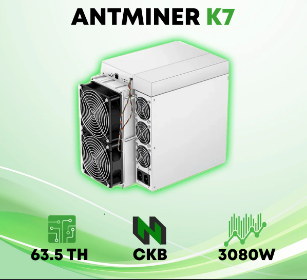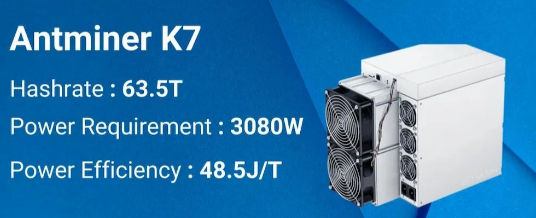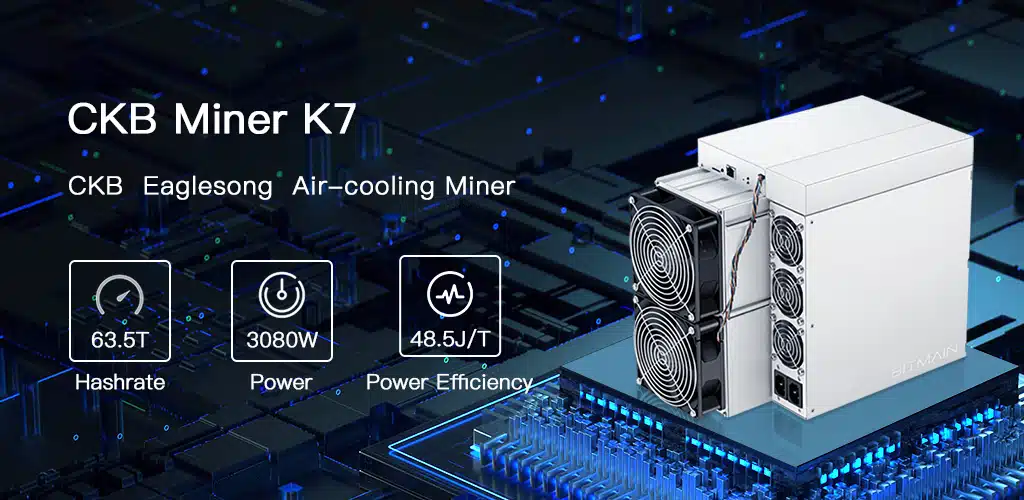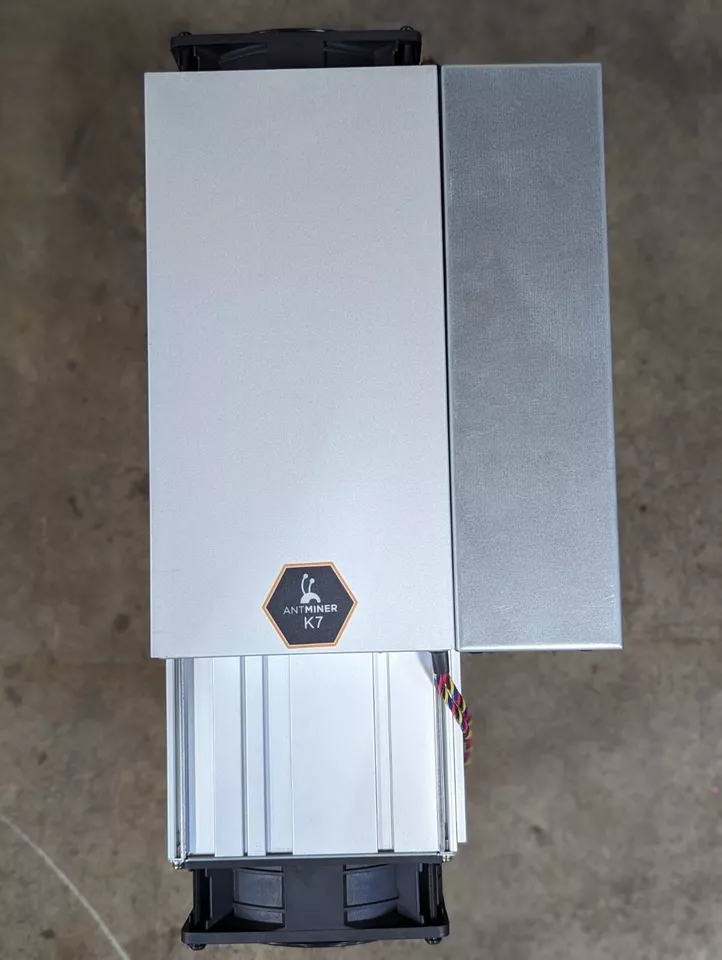How to Troubleshoot the CKB Miner K7 for Common Issues
The CKB Miner K7 is a state-of-the-art mining solution designed specifically for the Eaglesong algorithm, which powers the CKB cryptocurrency. With its impressive hashrate of 63.5 TH/s and energy efficiency of 48.5 J/TH, the K7 has quickly become a favorite among miners looking to maximize their profitability. However, like any piece of advanced hardware, the K7 can occasionally encounter issues that may disrupt its performance. In this article, we’ll explore some common problems that miners might face with the CKB Miner K7 and provide practical troubleshooting steps to resolve them.
Product Introduction: The CKB Miner K7
Before diving into troubleshooting, it’s essential to understand the key features and specifications of the CKB Miner K7. Developed by Bitmain, a leader in the cryptocurrency mining industry, the K7 is engineered for high performance and reliability. Its 276 hash chips are distributed across three hash boards, delivering a consistent hashrate of 63.5 TH/s (±3%). The miner’s dual AC input design (200-240V, 50-60Hz) ensures flexibility and stability, while its compact form factor (430 x 195.5 x 290mm) makes it suitable for various mining setups.
The K7 operates within a wide temperature range (0-40°C) and can withstand humidity levels of 10-90% RH (non-condensing), making it adaptable to challenging environments. Its advanced cooling system and durable construction ensure reliable operation even under continuous use. Additionally, the K7 comes with a 180-day warranty, backed by Bitmain’s exceptional customer support, providing miners with peace of mind.

Common Issues and Troubleshooting Steps
1. No Power or Miner Fails to Start
One of the most frequent issues miners encounter is the K7 failing to power on. This can be caused by several factors, including power supply problems, faulty connections, or internal hardware issues.
Troubleshooting Steps:

- Check Power Supply: Ensure that the power supply unit (PSU) is compatible with the K7’s requirements (200-240V, 50-60Hz). Verify that the PSU is functioning correctly by testing it with another device.
- Inspect Connections: Examine all power cables and connections to ensure they are securely plugged in. Loose or damaged cables can prevent the miner from receiving power.
- Reset the Miner: If the miner still doesn’t power on, try resetting it by unplugging it from the power source, waiting for 30 seconds, and then plugging it back in.
- Consult Support: If the issue persists, contact Bitmain’s customer support or your local distributor for assistance.
2. Overheating or Fan Malfunction
Overheating can significantly impact the performance and lifespan of the K7. Common causes include inadequate ventilation, dust buildup, or malfunctioning fans.
Troubleshooting Steps:
- Improve Ventilation: Ensure that the miner is placed in a well-ventilated area with sufficient airflow. Avoid overcrowding mining rigs to prevent heat buildup.
- Clean the Miner: Regularly clean the miner’s exterior and interior to remove dust and debris that can obstruct airflow. Use compressed air to clean the fans and heat sinks.
- Monitor Fan Speed: Check the fan speed through the miner’s control panel or software interface. If the fans are not spinning at the correct speed, they may need to be replaced.
- Replace Faulty Fans: If a fan is not working or making unusual noises, replace it with a compatible spare part. Bitmain provides easy access to replacement components.
3. Low Hashrate or Performance Degradation
A sudden drop in hashrate can be frustrating and may indicate underlying issues such as hardware malfunctions, network problems, or incorrect settings.
Troubleshooting Steps:
- Check Network Connection: Ensure that the miner is connected to a stable internet connection. Network instability can cause fluctuations in hashrate.
- Verify Pool Settings: Double-check the mining pool settings in the miner’s configuration interface. Incorrect pool addresses or credentials can lead to reduced performance.
- Inspect Hash Boards: Examine the hash boards for visible damage or loose connections. If a hash board is faulty, it may need to be replaced.
- Update Firmware: Ensure that the miner’s firmware is up to date. Bitmain regularly releases firmware updates to improve performance and fix bugs.
4. Frequent Crashes or Reboots
If the K7 crashes or reboots frequently, it could be due to overheating, power supply issues, or software glitches.
Troubleshooting Steps:
- Monitor Temperature: Use the miner’s monitoring tools to check the operating temperature. If the miner is overheating, take steps to improve cooling.
- Test Power Supply: Verify that the PSU is providing consistent power. Voltage fluctuations or insufficient power can cause the miner to crash.
- Reinstall Firmware: If software corruption is suspected, reinstall the miner’s firmware. Download the latest version from Bitmain’s official website and follow the installation instructions.
- Check for Hardware Faults: Inspect the miner’s components for signs of damage or wear. Faulty hardware may require professional repair or replacement.
5. Error Messages or Alarms
Error messages or alarms can indicate specific issues with the miner’s hardware or software.

Troubleshooting Steps:
- Decode Error Messages: Refer to the K7’s user manual to understand the meaning of specific error codes. Each code corresponds to a particular issue.
- Reset the Miner: A simple reset can sometimes clear temporary errors. Unplug the miner, wait for 30 seconds, and restart it.
- Update Software: Ensure that the miner’s software is up to date. Bitmain often releases patches to address known issues.
- Seek Professional Help: If the error persists, contact Bitmain’s technical support team for further assistance.
Preventive Maintenance for Optimal Performance
To minimize the likelihood of encountering issues with your CKB Miner K7, regular maintenance is essential. Here are some preventive measures to keep your miner running smoothly:
- Regular Cleaning: Dust and debris can accumulate over time, affecting the miner’s cooling efficiency. Clean the exterior and interior of the miner every few months using compressed air.
- Monitor Performance: Use monitoring tools to track the miner’s hashrate, temperature, and fan speed. Early detection of anomalies can prevent more significant problems.
- Firmware Updates: Stay updated with the latest firmware releases from Bitmain. These updates often include performance improvements and bug fixes.
- Proper Ventilation: Ensure that your mining environment has adequate airflow to prevent overheating. Consider using additional cooling solutions if necessary.
- Inspect Components: Periodically check the miner’s components for signs of wear or damage. Replace any faulty parts promptly to avoid disruptions.
Conclusion
The CKB Miner K7 is a powerful and efficient mining solution that offers exceptional performance for CKB cryptocurrency mining. However, like any sophisticated piece of equipment, it may encounter occasional issues that require troubleshooting. By understanding the common problems and following the practical steps outlined in this article, miners can quickly resolve these issues and maintain optimal performance.

Bitmain’s commitment to quality and support further enhances the value of the K7, ensuring that miners have access to the resources they need to keep their operations running smoothly. Whether you’re a seasoned mining operator or new to the industry, the CKB Miner K7 is a reliable and future-proof investment that can help you capitalize on the growing potential of the CKB ecosystem.